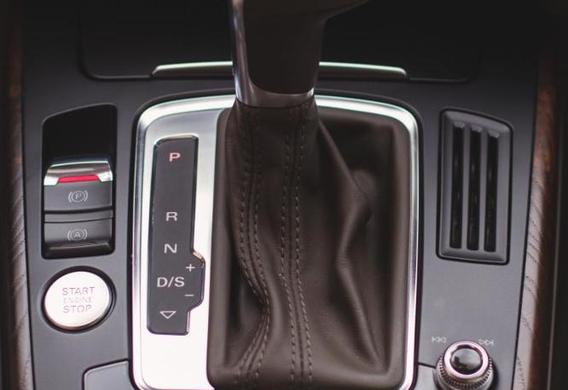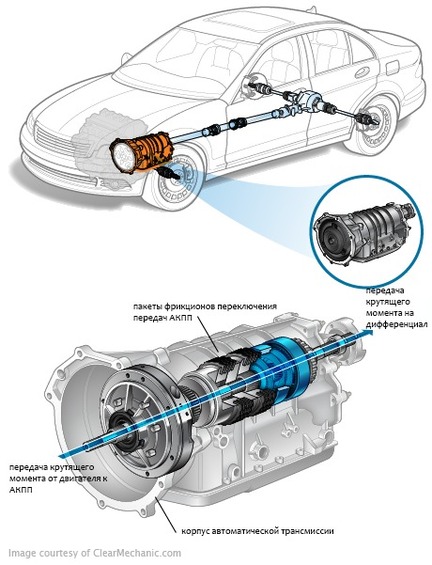
Appointment
In the not-too-distant past, when the variants of the variators and "robots" were not so widespread, the classic ACPR was the only automated alternative to the "mechanics".
The world's first automatic gearbox was released by General Motors. This transmission with the notional name Hydramatic has been proposed since 1940 as an option first on the models of the Oldsmobile and then on Cadillacs and Pontiac. In the mid-1960s, the United States finally approved (including by law) the generally accepted scheme for the inclusion of ACPR P-R-N-D-L.
The independent development of three auto giants-Ford, General Motors and Chrysler-was preceded by independent development. A system of several jagged wheels rotating around the central gears (the same planetary gear, an integral part of the classic automatic box) was originally introduced into the transmission of the first mass car-Ford T (produced from 1908 to 1927). Later, in the 1930s, General Motors introduced a semiautomatic transmission, in which the planetary transfer was operated by hydraulics. The third step on the way to "machine gun"-the introduction of hydromufts in the transmission (replaced by a hydrotransformer)-made Chrysler's company on the eve of World War II.
Device and operating principle
The classical automatic gearbox consists of: torque converter, several planetary gearboxes, couplings, gluttony and friction couplings, as well as a control unit. The task of the hydraulic transformer in the "machine" is akin to the clutch of the "mechanics"-to transmit and smoothly regulate the torque from the engine to the gearbox. Planetary gearboxes (usually two) in the automatic box are connected consecutially to provide the required number of steps. The gears shall be switched directly between them. They block one or two elements of planetary gearboxes to transmit torques to the transmission. The soft work of the fly is provided by the hydraulic cylinders, which are managed by the electronic control unit with fixed factory settings.

The operating mode of the automatic gearbox shall be chosen by the selector lever when it is installed in one of the following provisions: P, R, N, D, L or S.
P (Park) is a parking lock, a parking mode in which the car is still in the long run. The output shaft of the gearbox is locked and all controls are turned off.
R (Reverse) is the reverse. It is not included until the car is fully stopped, and many modern models are locked in R-mode. If the gearbox selector is in this position, it is impossible to have a car (as opposed to Park and Neutral).
N (Neutral)-Neutral mode, used in short-berthing or towing at close range. In this mode, all controls are off and the output shaft is unlocked, so the machine can move quietly.
D (Drive) is the main mode for moving forward, using all stages of the "machine".
1 or L (Low) is the lowest gear in which the box does not switch above the first stage. It is used in difficult road conditions where a small move is required, for example, with steep uphill or downhill slopes.
S (Sport) is the sport mode in which the "machine" switches steps at higher speeds of the shaft of the engine which are closest to the peak of the torque. This is necessary to optimize the power of the engine and accelerate faster.
2, 3 and 4 are the modes in which the gearbox does not switch above the second, third or fourth gear, respectively. They are optimal for mountain roads or hilly terrain, as well as frequent stops.
Classic assault rifles have several other useful modes of operation that are included separately.
O/D (Overdrive)-The "machine" mode in which the gearbox switches to higher steps. The engine operates mainly at low speed, saving fuel. Typically, Overdrive mode is activated by a single button directly on the selector lever or beside it.
W (Winter or Snow) is the "winter" mode of the gearbox. When it is turned on (usually by a button near the ACPR lever), the vehicle starts off the second gear. Switching takes place more gently and smoothly at reduced speed to avoid slipping of wheels on slippery road.
Kickdown is a mode of operation in which a gearbox can be quickly accelerated for overtaking. The mode is activated automatically when the throttle is pressed. At the same time, the "machine" is switched to one or two steps down.
Plus and Minus
The main advantages of the "sub-machine" are the comfort of driving the car. This is especially true in traffic jams and congestion, where parts of the stop, active clutch pedal and gear selection. Another advantage of automatic transmission is to provide a softer and more flexible operation of the engine and transmission.
The indisputable minus the "machine" in the lower CPD than the "mechanics". It is a significant loss of power in the gearbox, as well as higher fuel consumption (on average, 15 -20%). Also, for some of the drivers of the "old school", it is impossible to have a car "with a pusher" or to free a coking car. In addition, the price of a car with ACPR is generally higher than that of "mechanic".
Operating considerations
Due to the high cost of the repair of the APC, the owners are useful to know about some of the details of its exploitation in order to avoid possible breakdowns.
For example, leaving a car on uphill or downhill, it is recommended to use the parking brake. This means that the mechanism for blocking the output of the gearbox will last longer. To avoid major breakdowns and unscheduled maintenance, you can switch it to P and R modes only after a full stop of the machine.
There are several correct "symptoms" that will tell even the inexperienced driver about a possible rapid breakage of the "machine gun." These include sharp spagging and jolting, the smell of gari, and the unfamiliar noise or the noise of the gearbox that comes from the gearbox. If any of these symptoms are present, it is better to immediately contact the service to avoid any subsequent unexpected failure.
If ACPR broke down on the road and the car is not going, you should send the car immediately to the service. It is important to remember that many manufacturers do not recommend towing a car with ACPR at a distance of more than 80 km and at speeds above 30 km/h. Due to the lack of lubrication that is fed into the "machine" by the pump when the engine is running, the knots and parts of the box may be damaged by overheating. For long distances, the defective machine is better transported to the tow truck. As an alternative, the unhinged towing vehicle with the engine running is acceptable.







